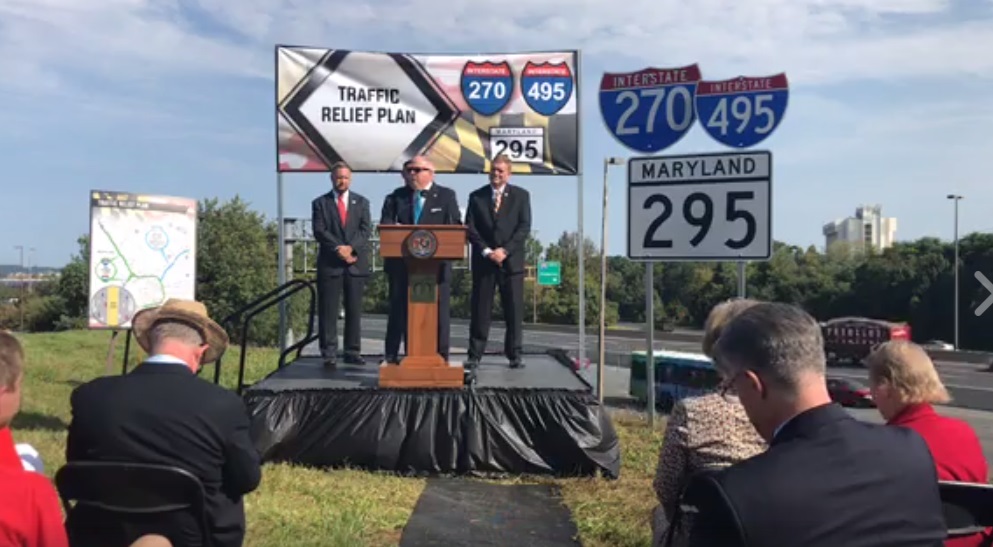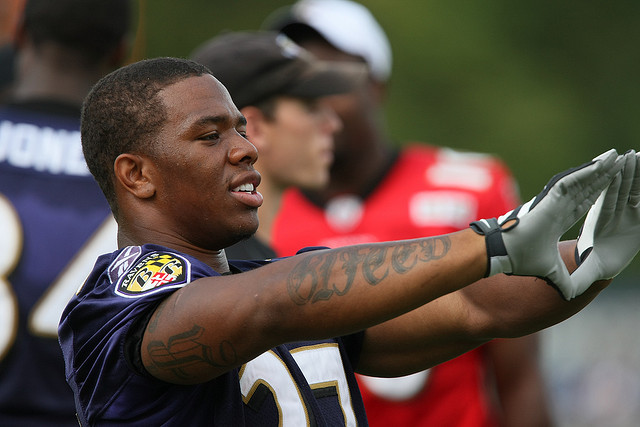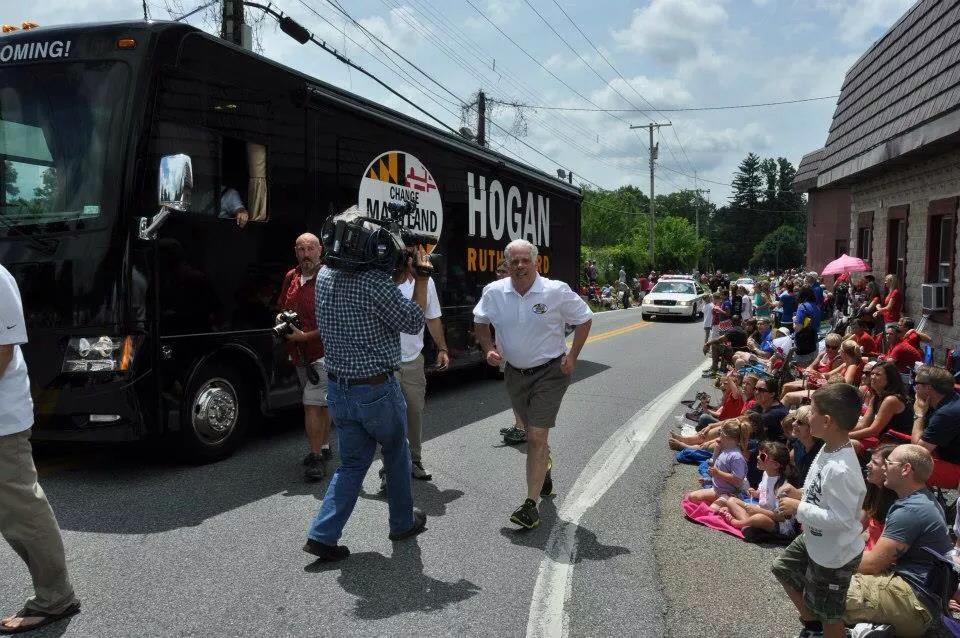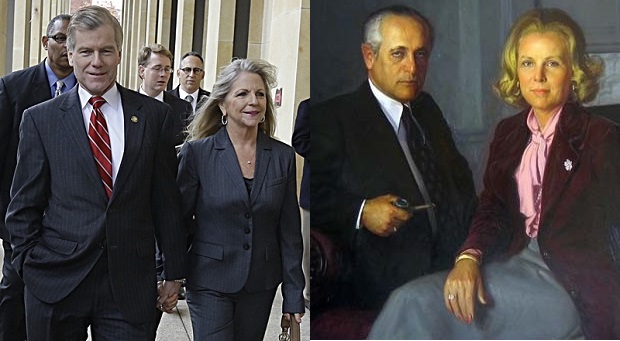By Barry Rascovar
For MarylandReporter.com
Gov. Larry Hogan never met a highway project he didn’t like. He’s a 1950s type of politician – solve all the state’s transportation gridlock and congestion by paving the countryside with lanes of new concrete.
He’s got a $9 billion plan that is a lollapalooza: Let construction giants build and pay for toll lanes on the Capital Beltway and the busy I-270 corridor from the beltway to Frederick – 70 miles of exclusive Lexus lanes – and let those companies reap the toll rewards so they can recoup a staggering $7.6 billion investment (the actual cost is likely to be substantially higher).
Then Hogan says he’ll take the state’s part of the profits and turn the Baltimore-Washington Parkway, now owned by the U.S. Park Service, into curb-to-curb concrete with nary a tree or woodlands in between.
He could re-name it the B-W Speedway.
It’s an all-highway solution straight out of the mid-20th century.
While conversation over this stunning proposal has barely started – Hogan consulted very few people it seems – there are a slew of points that deserve consideration before his back-to-the-future initiative gets too far off the ground:
The environmental damage, especially along the B-W Parkway, could be substantial.
How can the Park Service, even under a run-amuck Trump administration, turn the parkway’s 30 miles of mature woodlands over to a state eager to destroy those trees and vast stretches of scenic greenery? Is such a move even legally permissible?
Eight lanes of concrete – four new toll lanes (plus wide shoulders) and four toll-free lanes – would convert the parkway into a high-speed, tension-filled raceway.
For homeowners and neighborhoods abutting or close to the three roadways, Hogan’s plan is a calamity.
When a two-lane expansion of the B-W Parkway was proposed in 2011, Greenbelt leaders loudly objected, fearing the intrusion of the busy highway directly into the town. Imagine what a four-lane toll expansion will do to Greenbelt and other communities along the route.
The situation is far worse along high-density sections of I-270 and the Capital Beltway. Gigantic lawsuits and protests await Hogan when he tries to seize all that private property from businesses and homeowners – and then turn the land over to a consortium that would profit from those government land-grabs.
At the end of this project, Hogan may have done little to relieve highway congestion.
Every expansion of I-495 and I-695 (the Baltimore Beltway) has meant more cars on those roads and a quick return to the same level of congestion and added pollution. Los Angles has experienced the same thing with the famed I-405, where a $1.4 billion expansion didn’t help ease congestion at all.
The notion that Maryland taxpayers won’t be on the hook for a lot of the expense of these mega-projects isn’t realistic.
Hogan’s no-cost-to-taxpayers assertion may sound good to voters, but there’s virtually no way he can make it happen. These are ultra-expensive projects. For starters, seizing private properties through eminent domain can’t be privatized and will be extraordinarily expensive in the high-priced Washington suburbs.
Hogan also says the state’s share of profits from the I-495 and I-270 toll lanes will pay for the four toll lanes on the B-W Parkway. That doesn’t compute give the woeful record of the state’s last two toll projects – the InterCounty Connector and the I-95 Express Toll Lanes from Baltimore to White Marsh. Neither has come near the revenue numbers anticipated prior to construction.
Maryland’s toll authority already is in a heap of long-term financial trouble that would be compounded by these mega-projects.
The Department of Legislative Services says that between now and 2022, Maryland’s tolling facilities will take in $267 million less than projected but operating expenses will be $588 million higher than anticipated. This will force $1.7 billion worth of cuts to future projects and reduce the toll authority’s ability to float bonds by $3.7 billion.
Adding Hogan’s toll-road projects, even with a public-private contract, will scare the heck out of bond-rating agencies, which know full-well the state isn’t getting a free ride on construction projects of this size.
Transportation trends are not on Hogan’s side.
In good times, more cars and trucks use highways and toll roads. But in bad times, the reverse is true. Experts almost universally note the nation is ripe for an economic downturn. That means a big drop in gas tax and toll receipts for Maryland’s transportation agencies.
Rising fuel-mileage standards are hurting Maryland’s gas-tax receipts, too. So is the growth of electric vehicles on the road.
Meanwhile, the Maryland Transportation Authority’s debt service is soaring – a nearly eight-fold increase between 2007 and today with no decline in sight over the next 25 years.
The authority “will need to make long-term changes in order to remain financially stable,” DLS reported early this year. Hogan’s mega-projects ignore that suggestion and add to the state’s highway obligations.
Say goodbye to any future mass transit projects.
Hogan’s plan gives zero attention to a balanced transit solution in Central Maryland, instead putting all the state’s transportation eggs in a highway basket. That’s not the direction Virginia or other Eastern states with similar congestion woes are heading.
Such a vast expansion of I-295, I-495 and I-270 will create massive new gridlock at exit and access points.
How in the world could Russell Street in Baltimore handle an additional two lanes of rush-hour traffic? Ditto as the BW Parkway flows into New York Avenue in D.C. It would be a nightmare. Arterial roads and cut-through streets in adjacent neighborhoods along these three interstate highways would be clogged. The law of unintended consequences could kick in.
Passing environmental tests posed by federal and state laws and regulations could delay construction for many years, especially on the B-W Parkway.
Rest assured, legal challenges to every aspect of Hogan’s plan will be posed by environmental groups, well-to-do neighborhood associations along these routes and local governments.
Indeed, Hogan may be out of office by the time the first ground-breaking ceremony takes place – which may be part of his strategy.
What happened to helping Joe Six-Pack and the “forgotten Americans” who can’t afford E-ZPass transponders and frequent Lexus lanes?
There’s nothing in Hogan’s transportation vision that helps people at the lower end of the economy. No expansion of commuter buses, no shuttles connecting workers to spread-out job sites, no future mass transit such as a desperately needed east-west line through Baltimore.
Hogan’s highway proposal creates a windfall for the well-to-do and transportation businesses.
The plan is a winner for candidate Hogan.
Expect hefty campaign contributions from the construction and highway industries, from trucking concerns and from companies along these routes that figure to benefit from additional high-speed, interstate concrete lanes.
For voters, Hogan’s plan sounds great and makes an ideal campaign pitch. The devil is in the details, though, which Hogan won’t mention to voters.
How Democrats react to Hogan’s mega-plan will be fascinating to watch. Commuters want highway relief. But will they like what comes with the relief Hogan is offering?
Putting specifics before voters won’t be easy because the topic is complex. Voters like simple solutions and Hogan is very good at giving simple answers to exceedingly complicated problems.
How will the two other members of the Board of Public Works vote on Hogan’s plan?
They hold the key. Without BPW approval, Hogan’s super-highway plans are dead.
Comptroller Peter Franchot and Treasurer Nancy Kopp will have to dissect the extensive financial ramifications of Hogan’s proposal, the environmental impact, the legal liability such a huge seizure of private property might entail and the impact this would have on the lives of thousands of residents and businesses along those interstate routes.
About the only thing that seems assured is this: Hogan’s sweepingly ambitious highway-building plan is a long way from getting built.
Barry Rascovar’s blog is [email protected]. He can be reached at [email protected].







For readers who want a different perspective from highway solutions to congestion, I offer my “Citizen’s Guide to the Missing Green Rail Vision for the MD/Metro DC Region,” from January 2008.
You can find it here at: ps://www.dailykos.com/stories/2018/9/8/1794256/-Maryland-Hogan-s-Highways-will-still-leave-us-Stuck-in-Traffic-on-the-road-to-Global-Warming At the time I wrote this, in late 2007, the Purple Line had not been approved and the Silver Line into key Virginia suburbs had been stalled. The Silver Line part of Metro has now been built, and the Purple Line proceeding, though with a lot of controversy. Poor Baltimore, no luck.
As far as I know, no one else has attempted a comprehensive overview of the region’s inability to built new rail solutions to its congestion problems. County Executive Marc Elrich has substituted a pilot rapid bus line as an alternative; we don’t know yet if riders will take to the bus in the numbers needed.
I agree with Barry Rascovar’s assessment – and we usually don’t agree on policy matters.
Why is Rascovar so enthralled about mass transit ?
The Red Line was rejected by those who lived along the proposed route !
And when one gets off the line, they still need a bus, Uber, Lyft, taxi to get to their destination…
Also, try doing your weekly food shopping or any other type of large scale ( appliances, etc.)…